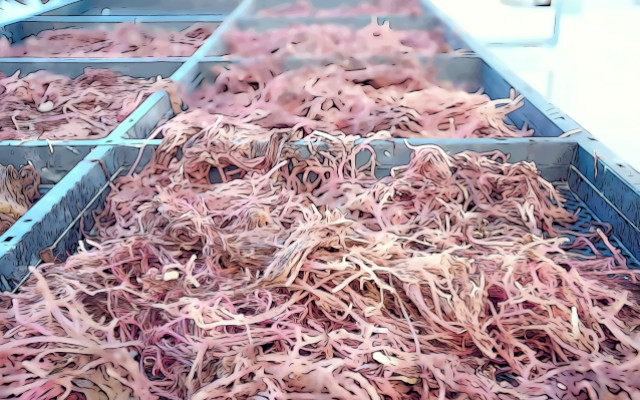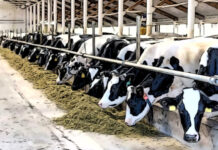An experimental study by the Department of Animal Science, University of California, Davis (Meo-Filho et al., 2024) suggests the effectiveness of seaweed Asparagopsis taxiformis to reduce methane emissions from pasture-raised beef cattle. (1)
The UK government has meanwhile declared that it intends to force farmers to use feed additives with the same function, such as Bovaer® from DSM-Firmenich. (2) A scientific review by the Beijing Academy offers a broader perspective. (3)
1) Algae for cattle to reduce methane emissions, introduction
Cattle breeding has been the subject of great attention in the last decade, due to its contribution to global greenhouse gas emissions. Also taking into account the demographic increase, associated with the growing demand for foods of animal origin for food security needs (FAO, 2022). (4)
Recent studies (including Beauchemin et al., 2022) have indicated the potential of administering some red algae (i.e. Asparagus taxiformis) to ruminants, to significantly reduce enteric emissions of GHGs (Greenhouse Gases) and in particular methane, as seen (5,6,7).
Pending further in vivo studies, FAO (Food and Agriculture Organization) had not yet considered the potential of this innovation in reducing the impact of livestock farming on the environment, in its recommendations ‘Five practical actions toward low-carbon livestock’ (2019). (6)
2) Asparagopsis taxiformis, in vivo study from the University of California
The study under consideration (Meo-Filho et al., 2024) tests the efficacy of bromoform-rich algae (Asparagopsis taxiformis), in pellet form, as an enteric methane (CH4) inhibitor in grazing beef cattle under real-world farming conditions.
The sample of twenty-four beef cattle – Wagyu and Angus crosses, with a mean live weight of 399 ± 21,7 kg – were assigned to two treatment groups (Asparagopsis and Control, A and C) and subjected to regular weighing, every 14 days.
2.1) Animal nutrition and growth
The feeding of Asparagopsis taxiformis algae pellets was organized into three phases: ramp-up (3 weeks), optimal phase (3 weeks) and decreasing phase (2 weeks).
Researchers recorded no differences between initial and final weekly live weight, mean daily gain and predicted dry matter intake in the two treatment groups.
2.2) Enteric emissions
Average enteric methane emissions (CH4), during the optimal and decreasing phases, were significantly reduced in cattle subjected to algae supplementation (115 g/day, compared to 185 g/day in the control group).
Both groups had similar carbon dioxide emissions (6,8 and 7,2 kg/day of CO2, respectively, for A and C). The emissions of dihydrogen H2 were instead higher in the group treated with Asparagopsis (3,4 versus 1,8 g/day).
2.3) Results
The results suggest that the algae feed additive Asparagopsis taxiformis, thanks to its natural and high bromoform content, has the potential to reduce enteric CH4 emissions from pasture-raised beef cattle without affecting their nutrient absorption.
Pastoral farming, which includes extensive grazing systems, is essential to the livelihoods of millions of people around the world. This innovation deserves further research, to contribute to the sustainability of livestock farming while respecting local cultures and biodiversity.
3) Research and innovation prospects
The FiBL scientific review published by the Institute of Feed Research at the Chinese Academy of Agricultural Sciences in Beijing (Liu et al., 2024) highlights the opportunity to extend the research to other algal species with low bromoform content, as well as other aspects.
Bromoform contained in A. taxiformis, as a halogenated analogue of methane, can specifically inhibit the activity of coenzyme M methyltransferase, thus blocking ruminal methanogenesis. Its potential dose-dependent toxicity profiles, however, deserve further investigation.
3.1) Seaweed and bioactive compounds
Current research on seaweed must therefore be improved, according to Chinese researchers, in the following directions:
– experiment with the use of more species of seaweed with low bromoform content, such as Bonnemaisonia hamifera, Dictyota bartayresii, Cystoseira trinodis e Saccharina latissimi;
– verify the role of bioactive compounds that algae are rich in (including hydrolyzed proteins, polysaccharides, and phlorotannins) in ruminant methane emissions;
– maintain awareness of possible, albeit remote, risks associated with residues of heavy metals (e.g. iodine, bromine) and bromoform in food products (e.g. milk, meat)
– develop sustainable and effective supply chains for the cultivation, conservation and processing of seaweed, in line with the objectives of the blue bioeconomy.
4) Provisional conclusions
Although there are more than 12.000 species of seaweed Worldwide, only 221 are considered to have commercial value, and even fewer species are intensively cultivated (FAO and WHO, 2022). (9)
‘We have concluded that the effectiveness of algae in reducing methane is indisputable. However, their application as a commercial feed additive is still influenced by factors such as safety, costs, political incentives and regulations.‘ (Liu et al., 2024).
Public investments in research are essential to explore the promising potential of this innovation in improving the sustainability of livestock farming.
Dario Dongo
Footnote
(1) P. Meo-Filho, JF Ramirez-Agudelo, E. Kebreab (2024). Mitigating methane emissions in grazing beef cattle with a seaweed-based feed additive: Implications for climate-smart agriculture, Proc. Natl. Acad. Sci. USA121 (50) e2410863121,
https://doi.org/10.1073/pnas.2410863121
(2) John Ely. New Bovaer fears: UK Government ‘commits’ to giving ALL cows in England controversial feed by 2030 – amid ongoing dairy boycott over ‘toxic’ additive. Daily Mail. December 6, 2024 https://tinyurl.com/3tjkkwj7
(3) Yunlong Liu, Mi Zhou, Qiyu Diao, Tao Ma, Yan Tul (2024). Seaweed as a feed additive to mitigate enteric methane emissions in ruminants: Opportunities and challenges. Journal of Integrative Agriculture. https://doi.org/10.1016/j.jia.2024.09.036
(4) Marta Strinati, Dario Dongo. Animal foods needed for nutrition and health, FAO report. FT (Food Times). May 8, 2023
(5) Antonio Gattuli. Algae against the greenhouse effect. GIFT (Great Italian Food Trade).
(6) Roque, B.M., Brooke, C.G., Ladau, J. et al. (2019). Effect of the macroalgae Asparagopsis taxiformis on methane production and rumen microbiome assemblage. Animal microbiome 1, 3. https://doi.org/10.1186/s42523-019-0004-4
(7) Dario Dongo. Ruminant algae to cut methane emissions. FT (Food Times). January 12, 2023
(8) Dario Dongo, Marina De Nobili. Livestock, FAO proposes 5 areas of action to reduce greenhouse gas emissions. FT (Food Times). August 29, 2020
(9) FAO, WHO (2022). Report of the expert meeting on food safety for seaweed: current status and future perspectives. Rome, 28-29 October 2021. Food Safety and Quality Series No 13. Rome. ISBN: 978-92-4-005853 https://tinyurl.com/z2kec5wt
Dario Dongo, lawyer and journalist, PhD in international food law, founder of WIISE (FARE - GIFT - Food Times) and Égalité.








